Equilibrium of a rigid object
Assume two or more forces act on a rigid object. The total force on the object is the
sum of all the external forces. According to Newton's third law, the sum of all the
internal forces is zero. We have
Ftot = MaCM.
If the total force acting on the object is zero, the center of mass of the object will
not accelerate. The object is in translational equilibrium.
If the CM of the object is at rest, it will stay at rest, if it is moving with constant
velocity, it will keep on moving with constant velocity.
For the object to be in rotational equilibrium, the
total torque on the object must be zero. The total torque on the object is the
vector sum of all the external torques. According to Newton's third law, the sum of
all the internal torques is zero.
For an object to be in mechanical equilibrium,
the net external force and the net external torque acting on the object have to be zero.
Ftot = 0,
τtot = 0.
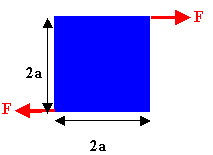 The total torque can be nonzero, even though
Ftot = 0. Consider the situation shown in the figure
on the right. The square is initially at rest in
the x-y plane. The z-axis points out of the page. The total force on the square is zero.
The CM of the square will stay at rest. The total torque about the CM is
not zero. τtot = -2 √2 a F sin(45o)
k
= -2aF k.
The total torque can be nonzero, even though
Ftot = 0. Consider the situation shown in the figure
on the right. The square is initially at rest in
the x-y plane. The z-axis points out of the page. The total force on the square is zero.
The CM of the square will stay at rest. The total torque about the CM is
not zero. τtot = -2 √2 a F sin(45o)
k
= -2aF k.
The square will have angular
acceleration pointing into the page.
Two forces, equal in magnitude and opposite in direction, whose lines of action do not
pass through the same center, are called a couple.
A couple produces a torque about the center.
No net external force implies that the center of mass of the object is
at rest or moving with constant velocity.
No net external torque implies that the object
either does not rotate or that it rotates with constant angular velocity. For an object
in mechanical equilibrium there exists some inertial reference frame in which
the object's center of mass is at rest. If in this frame the object also does
not rotate, it is in static mechanical equilibrium.
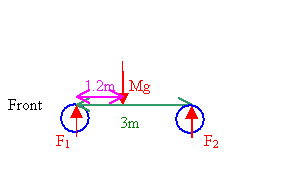 Problem:
Problem:
A 1500 kg automobile has a wheelbase (the distance between the axles) of
3 m. The center of mass of the automobile is on the centerline at a point 1.2 m
behind the front axle. Find the force exerted by the ground on each
wheel.
Solution:
- Reasoning:
The car is in static equilibrium, Ftot = 0,
τtot = 0.
- Details of the calculation:
The force of gravity Mg acts on the center of mass of the object. It produces no torque
about the CM.
Ftot = F1 + F2 - Mg = 0.
τtot
= F2(1.8 m) - F1(1.2 m) = 0.
F1 = 1.5 F2.
2.5 F2
= Mg = 14700 N, F2 = 5880 N.
F1 = 8820 N.
The force exerted by the ground on each rear wheel is F2/2 = 2940 N and the force
exerted by the ground on each front wheel is F1/2 = 4410 N.
When an object is placed in a uniform gravitational field, then the force of gravity
produces no torque about the center of mass of the object. We can always represent the
gravitational force as an arrow pointing straight towards or away from the center of mass
of the object. For this reason, the center of mass is also called the
center of gravity of the object.
Equilibrium does not guaranty stability.
Example:
A ball and a bowl
The ball is in stable equilibrium at the bottom of a bowl.
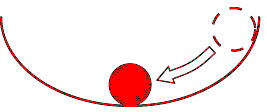
The ball is in unstable equilibrium at the top of a bowl.
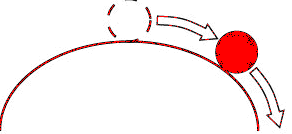
Objects are in stable mechanical equilibrium
if their potential energy increases when they are slightly disturbed.
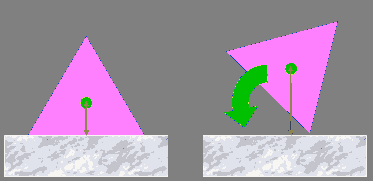 An object in static equilibrium has
static translational stability,
if, when displaced from its equilibrium position by a small amount,
a restoring force accelerates it back towards the equilibrium
position.
An object in static equilibrium has
static translational stability,
if, when displaced from its equilibrium position by a small amount,
a restoring force accelerates it back towards the equilibrium
position.
An object in static equilibrium has
static rotational stability,
if, when rotated away from its equilibrium orientation through a small
angle, a restoring torque results in angular acceleration back towards
the equilibrium orientation.
An object has static rotational stability if its center of gravity is
located above its base of support. A minimum of 3 non-collinear contact points form a base.
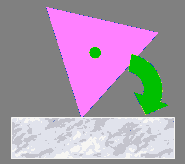 When an object with static stability is disturbed too much, the limit of static stability can be reached. The
limit of static rotational stability is reached when the object's center of gravity is no longer located over its base of support.
When an object with static stability is disturbed too much, the limit of static stability can be reached. The
limit of static rotational stability is reached when the object's center of gravity is no longer located over its base of support.
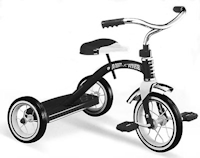 A tricycle has a base with 3 contact points. It
has has static rotational stability.
A tricycle has a base with 3 contact points. It
has has static rotational stability.
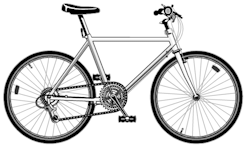 A bicycle has only 2 contact points. It is statically unstable and tips over easily.
A bicycle has only 2 contact points. It is statically unstable and tips over easily.
 The total torque can be nonzero, even though
Ftot = 0. Consider the situation shown in the figure
on the right. The square is initially at rest in
the x-y plane. The z-axis points out of the page. The total force on the square is zero.
The CM of the square will stay at rest. The total torque about the CM is
not zero. τtot = -2 √2 a F sin(45o)
k
= -2aF k.
The total torque can be nonzero, even though
Ftot = 0. Consider the situation shown in the figure
on the right. The square is initially at rest in
the x-y plane. The z-axis points out of the page. The total force on the square is zero.
The CM of the square will stay at rest. The total torque about the CM is
not zero. τtot = -2 √2 a F sin(45o)
k
= -2aF k. Problem:
Problem:

 An object in static equilibrium has
static translational stability,
if, when displaced from its equilibrium position by a small amount,
a restoring force accelerates it back towards the equilibrium
position.
An object in static equilibrium has
static translational stability,
if, when displaced from its equilibrium position by a small amount,
a restoring force accelerates it back towards the equilibrium
position. When an object with static stability is disturbed too much, the limit of static stability can be reached. The
limit of static rotational stability is reached when the object's center of gravity is no longer located over its base of support.
When an object with static stability is disturbed too much, the limit of static stability can be reached. The
limit of static rotational stability is reached when the object's center of gravity is no longer located over its base of support. A tricycle has a base with 3 contact points. It
has has static rotational stability.
A tricycle has a base with 3 contact points. It
has has static rotational stability. A bicycle has only 2 contact points. It is statically unstable and tips over easily.
A bicycle has only 2 contact points. It is statically unstable and tips over easily.